From Minor Oil
Crops, FAO Agricultural Bulletin No. 94
by the Food And Agriculture Organization of the United Nations
Principals of
extraction
The
extraction of oil from an oil bearing commodity involves some or all of
the steps shown in the flow diagram shown overleaf, depending on the
particular commodity to be processed, the scale of operation and the
technical options available to the processor.
Decortication
The first stage of the process sometimes requires the separation of the
oil bearing part of the plant be it a nut, fruit or seed. The process
is generally referred to as decortication or dehulling. Seeds with thin
testa similar to rapeseed or sesame seed can be processed without
decortication.
Breaking
In most cases the oil bearing material is then broken into smaller
pieces by pounding in a pestle and mortar or by manual or motorised
grinding. When motorised oil expellers are used the decorticated or
undecorticated material can often be fed directly to the expeller.
Cooking
The next step involves heating the oil bearing material, sometimes with
the addition of a little water to assist in the rupture of oil bearing
cells and in the liberation of oil. At small scale this is carried out
in a pan over a fire but mechanised heaters or kettles are available
and used in commercial plants small scale heater-Cecoco.
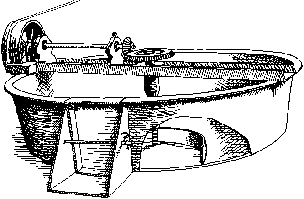
Figure 1 - Small Scale Heater (scorcher) Cecoco
Extraction
The oil bearing material is now ready for oil extraction. Five basic
technical options exist; hot water floatation, ghanis, manual presses,
powered expellers and solvent extraction.
Traditional
Methods
1. Hot water floatation is probably the simplest method and i" still
used in many rural areas. The ground material is placed in boiling
water and simmered for several hours. On removing from the fire and
cooling the oil floats to the surface and is skimmed off. In general
the oil is then heated in a shallow pan to drive off the last traces of
water. This improve" the keeping quality of the oil as water has a
catalytic role in the development of rancidity in oils. The extraction
efficiency is generally low, and problems often occur with the
formation of oil-water emulsions which makes the final separation
difficult. In some cases salt is used to break such emulsions.
2. In many countries a large rotating pestle and mortar system known as
a ghani is used for oil extraction. Ghanis are powered by animals or
motors (power-ghanis) although sometimes human power is used. The
mortar is firmly fixed in the ground and as the pestle rotates oil is
released by friction and pressure and runs out of a small aperture at
the base of the mortar. A typical one bullock ghani can process 40 kg
of material/day. In the case of power-ghanis either the pestle or
mortar is fixed, the other rotating. Power ghanis usually are operated
in pairs and have a typical capacity of 100 kg/day. The extraction
efficiency is generally greater than animal units.
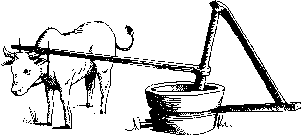
Figure 2 Traditional Animal Powered Ghani
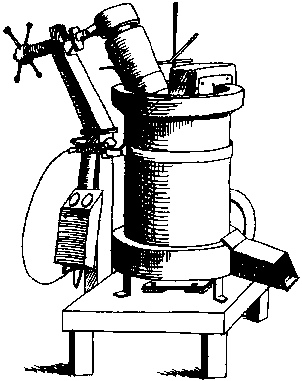
Figure 3 Power Ghani
3. Other traditional methods are still used to extract oil from oil
bearing materials. Such systems include the use of heavy stones,
wedges, levers and twisted ropes to apply pressure to the material and
so squeeze out oil. They are inefficient, of low capacity and labour
intensive.
Manual Presses
Traditional presses are now increasingly being replaced by better
engineered, more efficient mechanical presses. Many different types of
mechanical press are in use but they fall into two basic types, plate
presses and ram presses. In the first type a plate or piston is forced
into a perforated cylinder containing the oil bearing material by means
of a worm. In some cases hydraulic jacks have been used, care is needed
to make sure there is no leakage of hydraulic fluid that might
contaminate the edible oil. In a ram press a piston forces the oilseed
forward in a perforated cage fitted with an adjustable choke at the
outlet, which controls the pressure. Ram presses provide a greater
shearing action than simple screw presses and have been found to be
considerably more efficient for some raw materials. It is important
that when selecting a particular type of press its suitability for the
raw material to be processed is confirmed.
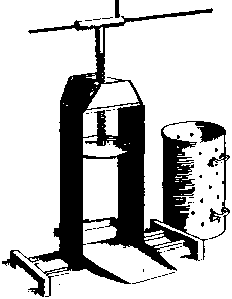
Figure 4 - Plate Press
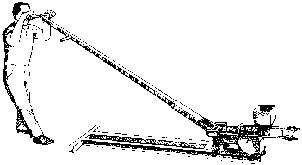
Figure 5 - Ram Press
Powered
Presses
To obtain greater throughputs and extraction efficiencies it becomes
necessary to use powered devices and the oil expeller is the most
common of these. A whole range of expellers are available with
capacities ranging from a few kg/hr up to tons/hr. They all work on the
same basic principle. The raw material, which may have been previously
heated to aid in the release of oil, is fed continuously to the
expeller where it is fed by the wormshaft into a horizontal cylinder. A
controllable pressure is built up in the cylinder by means of an
adjustable choke at the cylinder exit. The internal pressure ruptures
oil cells in the material and oil flows out through perforations in the
cylinder cage. Some care has to be taken when selecting an expeller for
a particular commodity. Many Have been designed for particular
applications, in terms of internal pressure, amount of shearing action
etc. Certain types tend to be more adjustable and hence less product
specific than others.
Small scale
expellers c 40 kg/hr
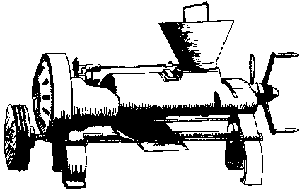
Figure 6 - Cecoco
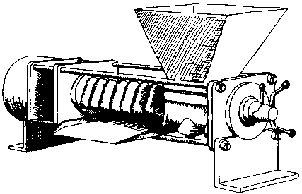
Figure 7 - Mini 40
None of the above extraction systems are able to remove all of the oil
from a material. In most small scale rural situations this is of little
or no importance as the cake, that remains after the oil has been
removed, finds uses in local dishes, in the manufacture of secondary
products or for animal feed. Some raw materials however do not release
oil by simple expelling; the most notable being rice bran. In order to
remove oil from commodities that do not respond to expelling or to
extract the final traces of oil after expelling it is necessary to use
solvent extraction. Solvent extraction is a high technology process
that has to be carried out at comparatively large scale. Capital costs
are high. Essentially the process is one of continuous countercurrent
extraction with the raw material flowing in one direction against a
solvent; usually hexane. After oil extraction the solvent passes to a
recovery plant where the solvent is stripped off under vacuum. The
crude oil then passes on for refining. Due to the large scale involved
it would seem unlikely that solvent extraction would find much
application in minor oil product processing.
Refining
The last stage in the processing of an oil is refining which includes
some or all of the following treatments:- filtering, neutralisation,
winterising, bleaching, deodorisation and degumming and filtering. In
many cases refining is not a necessary stage in traditional processing
systems as local palates are accustomed to the flavour of unrefined
oils and in many parts of world these flavours are in fact preferred to
the blandness of a fully refined oil. Many crude oils contain free
fatty acids (FFA) which impart unpleasant odours and flavours. The
FFA's are neutralised by treating the oil with a carefully controlled
quantity of caustic soda solution. In larger oil refineries the caustic
soda washes are sold on for soap manufacture and are known as soap
stock.
Winterising involves allowing the oil to stand at low temperatures,
during which time higher melting glycerides crystallise and are
separated by filtration.
Some oils are rather dark in colour and are bleached by the addition of
a small amount of bleaching earth or activated carbon prior to
filtration. Many commercial plants in fact bleach crude oil as routine
and then add a controlled amount of colour in order to produce a
standard final product.
De-odourising involves sparging steam through the oil, usually under
vacuum. The steam removes volatile odours, for example the coconut
smell of coconut oil.
In some cases it is also necessary to treat oils with small amounts of
water in order to remove gums and mucilages that are released along
with oil as the plant cells rupture during extraction. These gums
mainly consist of phospholipids. The above treatment, with heat, causes
the gums to flocculate after which they may be removed by
centrifugation or settling.
Oils produced at small scale in rural areas are rarely given all but a
rudimentary level of refining, usually filtration. However clarity can
be improved by filtration through cloth packed with fine sand or
charcoal.
Vegetable food oils are of great importance in the diet, they are a
concentrated form of energy vital to people all over the world. In
developing countries poor people rarely have access to or can afford
cooking oils from larger refineries and still rely on minor oil crops
to meet their needs. In some cases viable and important local industry
and trading is involved.
Back to
Macadamia Smooth Shell Page
Macadamia Rough Shell Page
|
© FAO, 2018
|
Bibliography
Axtell, B. L. "Principals of Extraction." Minor Oil Crops, Individual
monographs, FAO Agricultural Bulletin No. 94, Research by R.
M. Fairman, Food And
Agriculture Organization of the United Nations, 1992,
FAO, www.fao.org/3/X5043E/x5043E09.htm.
Accessed 14 Dec. 2020.
Published 27 Sept. 2021 LR
|






